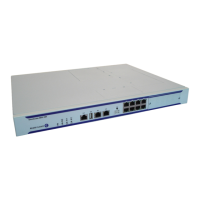Configuration Commands
Page 326 7750 SR OS Interface Configuration Guide
high-prio-only
Syntax high-prio-only percent
no high-prio-only
Context config>port>ethernet>access>egr>qgrp>qover>q
config>port>ethernet>access>ing>qgrp>qover>q
config>port>ethernet>network>egr>qover>q
Description The high-prio-only command specifies the percentage of buffer space for the queue, used exclu-
sively by high priority packets. The specified value overrides the default value for the context.
The priority of a packet can only be set in the SAP ingress QoS policy and is only applicable on the
ingress queues for a SAP. The high-prio-only parameter is used to override the default value derived
from the network-queue command.
The no form of this command restores the default high priority reserved size.
Parameters percent — The percentage reserved for high priority traffic on the queue. If a value of 10KBytes is
desired, enter the value 10.
Values 0 — 100, default
mbs
Syntax mbs size-in-kbytes
no mbs
Context config>port>ethernet>access>egr>qgrp>qover>q
config>port>ethernet>access>ing>qgrp>qover>q
config>port>ethernet>network>egr>qover>q
Description The Maximum Burst Size (MBS) command specifies the default maximum buffer size for the tem-
plate queue. The value is given in kilobytes.
The MBS value is used by a queue to determine whether it has exhausted all of its buffers while
enqueuing packets. Once the queue has exceeded the amount of buffers allowed by MBS, all packets
are discarded until packets have been drained from the queue.
The sap-ingress context for mbs provides a mechanism for overriding the default maximum size for
the queue.
The sum of the MBS for all queues on an ingress access port can oversubscribe the total amount of
buffering available. When congestion occurs and buffers become scarce, access to buffers is con-
trolled by the RED slope a packet is associated with. A queue that has not exceeded its MBS size is
not guaranteed that a buffer will be available when needed or that the packets RED slope will not
force the discard of the packet. Setting proper CBS parameters and controlling CBS oversubscription
is one major safeguard to queue starvation (when a queue does not receive its fair share of buffers).
Another is properly setting the RED slope parameters for the needs of services on this port or chan-
nel.
If the CBS value is larger than the MBS value, an error will occur, preventing the MBS change.

